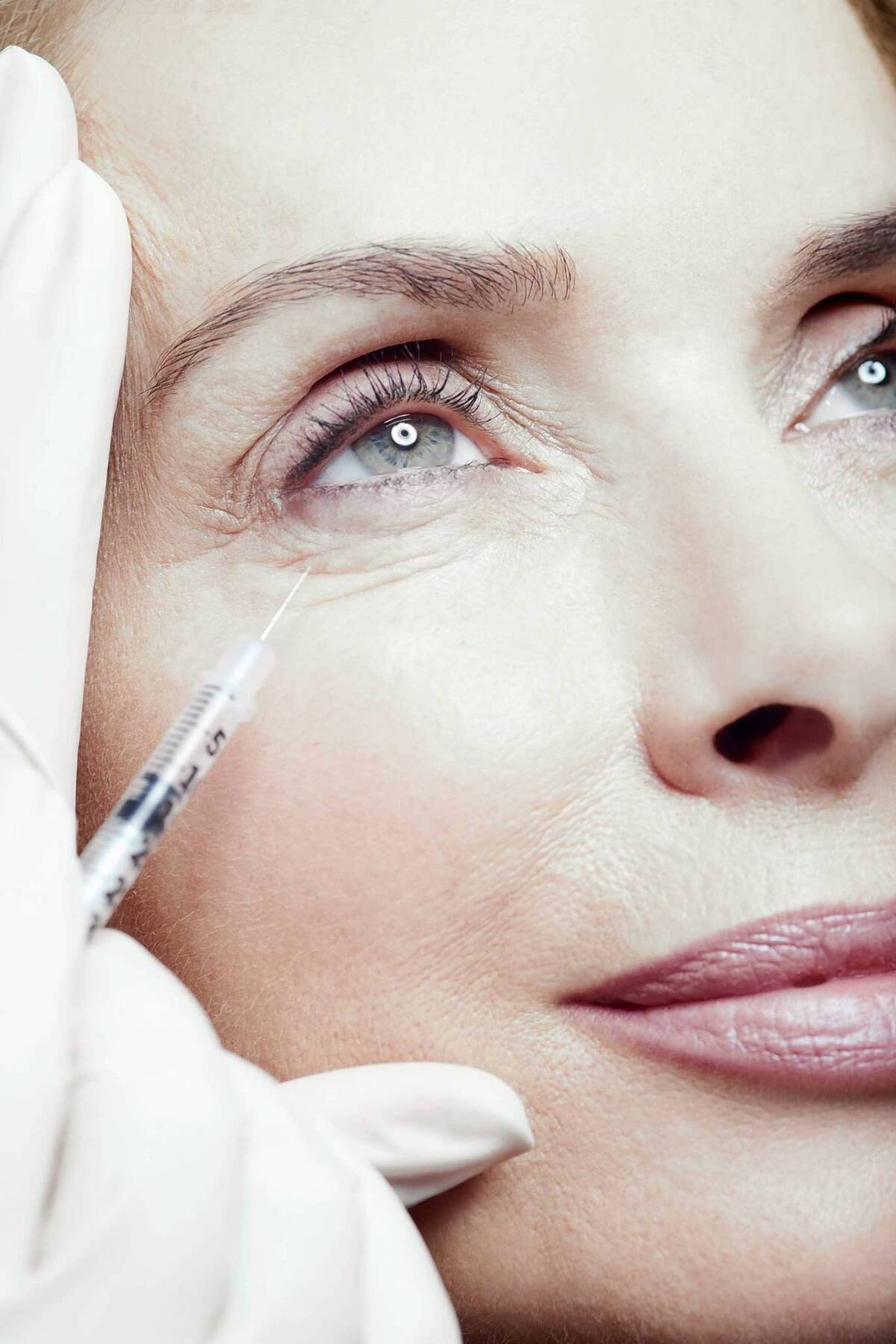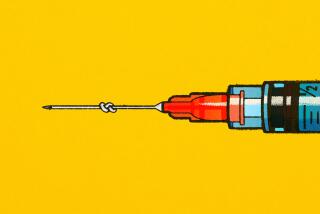Newest facial fillers that erase lines without surgery

- Share via
If you’re over 40, you probably remember that first time someone called you “Ma’am” or “Sir.” It almost surely hurt, no matter how young and fit you felt. Evidently, your age was showing in those wrinkles and sags.
Some decide to live with it; others do everything they can to obliterate the evidence. Today there are more nonsurgical options than ever to erase lines, thanks to new developments in the world of fillers.
Thirty years ago, a filler such as Zyplast (cow collagen) would be injected to bring a line or scar up to the level of the surrounding skin. But that ignored the other signs of aging, such as under-eye hollows and sunken cheeks, a softer jawline, narrower lips and a flatter bridge on the nose — all caused by shrinking bones, shrinking fat pads and thinning collagen (the substance in skin that makes it firm and plump).
“As we get older, we get laxity in the skin because we’ve lost the volume over which to drape it,” says Dr. Ava Shamban, assistant clinical professor of dermatology at the UCLA-Geffen School of Medicine. “That’s why if you do a face lift on an older person and pull it tight, it can look skeletal. It’s much better to add volume, so that you look appropriately rounded and full — the sign of a youthful appearance — and not gaunt and bony.”
Enter the new generation of volumizing fillers that allow doctors to recontour the face more efficiently than ever before. For example, judicious use of a thin filler underneath a flattened brow bone will result in a brow lift. And injecting a thicker filler along a sunken cheekbone will not only round out the cheeks but lift up the nose-to-mouth lines too. Here are some of the newest tools in the effort to look younger.
Laviv
Approved by the Food and Drug Administration after nine years of clinical studies, Laviv is called a “biological tissue-stimulating treatment” — a wrinkle filler that’s seeded from your own skin cells so that it carries a low risk of rejection or allergic reaction. Hence Laviv’s reputation as an all-natural filler, which is not lost on the patients of Beverly Hills dermatologist Dr. Lisa Chipps, director of dermatologic surgery at Harbor-UCLA Medical Center. “Some of them don’t like the idea of injecting a foreign substance into their bodies and love the idea of using their own cells,” she says. This grow-your-own collagen starts with a tiny biopsy of skin from behind the ear, closed by a stitch so small it’s nearly invisible. At a lab, skin cells called fibroblasts (the building blocks of collagen, elastin and hyaluronic acid, which make skin plump and firm) are isolated, purified and multiplied millions of times.
Although the resulting liquid is not thick enough to use on hollow cheekbones, it excels at detail work such as plumping out smile lines, pucker lines, “marionette” lines, pitted acne scars and the thin, crepey skin under the eye. Shamban, one of the clinical investigators in the Laviv trials, says: “I use it for full-face rejuvenation — basically, anywhere a patient has a wrinkle. Because these fibroblasts, these little collagen-making machines, get to work and not only fill the lines but improve pores, pigmentation and overall skin texture. There seems to be a fresher look to the whole area where the skin was injected.”
Laviv isn’t a quick fix, since it takes six weeks from that snip behind your ear to the delivery of the vials of liquid. But the treatment lasts two or more years, a dramatic improvement over more temporary fillers (such as Restylane or Juvederm) that need to be repeated every year. An entire Laviv treatment — from snip to injections — typically costs around $3,000 to $3,500. Restylane or Juvederm costs about $600 to $800 per syringe — about as much as is needed to fill in the smile lines on an average face.
Physicians qualified to inject Laviv are listed on https://www.mylaviv.com, but the local doctors who ran the safety and efficacy trials required by the FDA are Shamban (Santa Monica and Beverly Hills), Dr. John Joseph (Beverly Hills), Dr. Rhonda Rand (Beverly Hills), Dr. Nancy Silverberg (Newport Beach) and Dr. Stacy Smith (San Diego).
Hyaluronic acids
A synthetic form of a substance found in skin, a sugar that binds water to add volume, hyaluronic acids are already the most popular fillers on the market (think of brand names Restylane, Perlane, Juvederm). But a new entrant, Belotero, is said to have advantages over the others because it can be injected in the very thin skin under the eyes or near the mouth without causing a bluish hue (a small risk with the others), and it may have slightly more longevity. This filler has been approved by the FDA and will be more widely available in December or sooner if a marketing injunction filed by a competitor is lifted. If your doctor already offers Belotero, he or she is one of the lucky “old customers” who are unaffected by the injunction, which applies only to new customers
On the cusp of FDA approval is Voluma, the first hyaluronic acid that, due to its large particle size, can add real volume to the cheeks, cheekbones and chin. “That’s going to be very exciting,” says Shamban, adding that it’s been used safely in Europe and Australia. And there’s news about good old Restylane. Although it’s been on the market for years, it recently received the FDA’s blessing to be used for lip revolumization. “That’s the only hyaluronic acid with a label for the lips,” Shamban says.
Neuromodulators
Joining Botox and Dysport (trade names for the botulinium toxin that treats wrinkles created by the muscles of expression) is Xeomin. Like its brethren, Xeomin is injected into the muscle to relax it and prevent the overlying skin from moving. While Xeomin was FDA-approved specifically to treat the vertical frown lines between the eyebrows, it can (like Botox and Dysport) be used to smooth out forehead lines, lessen crow’s feet, relax the muscle that pulls down the corners of the mouth and soften the bands in the neck. Doctors who use it like it because it stores better in their office than the others and is less likely to cause an allergic reaction. Xeomin will be widely available in December at the latest but is already being injected by doctors who were grandfathered in (i.e., using it prior to a marketing challenge filed by a competitor in March).
Consumer tips
All this competition among drug companies is turning into good news for the consumer. Watch for rebates or specials from Allergan (Juvederm and Botox), Medicis (Restylane, Perlane and Dysport) and Merz (Belotero and Xeomin) — which should make fillers more accessible since treatments can cost from around $300 for Botox to more than $3,000 for Laviv.
But Chipps says job one for the consumer “is to choose a physician who’s trained and experienced in using fillers, and that’s most commonly a board-certified dermatologist or a facial plastic surgeon.” Find one at Aad.org or Plasticsurgery.org.






